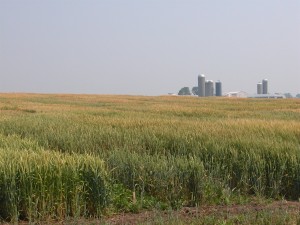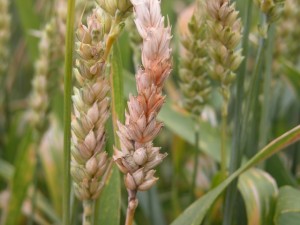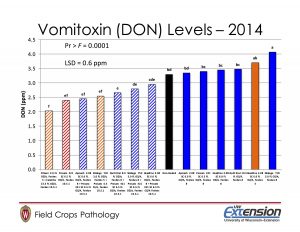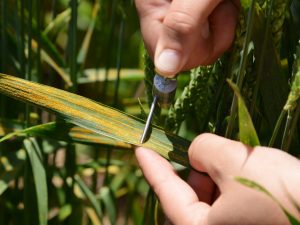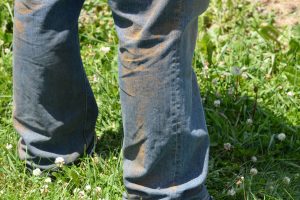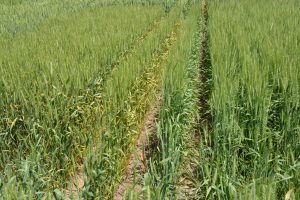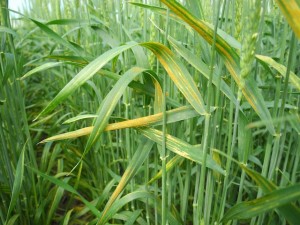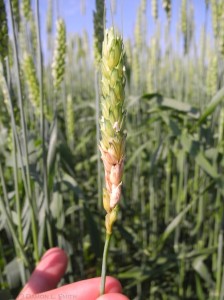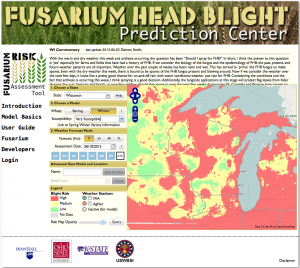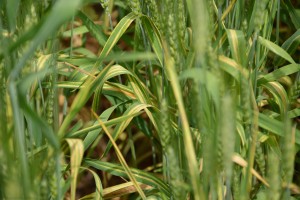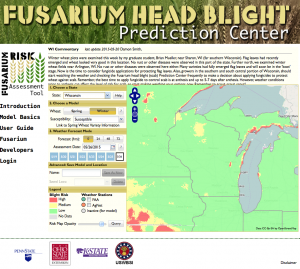Shawn P. Conley, Extension Soybean and Small Grains Agronomist, University of Wisconsin-Madison

Figure 1: Symptoms of Fusarium head blight (scab) on a wheat head.
The 2015 growing season has been fairly challenging for managing winter wheat diseases. Many fields we have observed have some level of disease. Fusarium head blight (FHB or scab) is the primary disease observed in all locations from the southern portion of the state on up through Fond du Lac. In locations near Janesville, some varieties of winter wheat not sprayed with a fungicide have FHB incidence and severity levels close to 50%. Significant yield loss and quality issues, including high levels of deoxynivalenol (also known as DON or vomitoxin) will be a problem as farmers being to harvest grain in a couple of weeks. Fields should be assessed now for damage by FHB to understand how much DON might be expected in grain at harvest.
What does scab look like? Diseased spikelets on an infected grain head die and bleach prematurely (Fig. 1). Healthy spikelets on the same head retain their normal green color. Over time, premature bleaching of spikelets may progress throughout the entire grain head. If infections occur on the stem immediately below the head, the entire head may die. As symptoms progress, developing grains are colonized causing them to shrink and wrinkle. Often, infected kernels have a rough, sunken appearance, and range in color from pink or soft gray, to light brown. As wheat dries down, visual inspection of heads for scab will become more difficult.
Why is identifying scab important? Scab identification is important, not only because it reduces yield, but also because it reduces the quality and feeding value of grain. In addition, the FHB fungus may produce mycotoxins, including DON or vomitoxin, that when ingested, can adversely affect livestock and human health. The U.S. Food and Drug Administration has set maximum allowable levels of DON in feed for various animal systems, these are as follows: beef and feedlot cattle and poultry < 10ppm; Swine and all other animals < 5ppm.
What should I do to prepare for wheat harvest?
- Scout your fields now to assess risk. Wheat is beginning to mature. As maturity progresses over the next couple of weeks, it will be increasingly difficult to assess the incidence and severity of the infection. Understanding a field’s risk will help growers either field blend or avoid highly infected areas so entire loads are not rejected.
- DO NOT spray fungicide now. Research has demonstrated that the window of opportunity to manage FHB with fungicides is at the beginning of anthesis and only lasts about 7 days. Applications later than 7 days after the start of anthesis are not effective in controlling FHB. In addition, most fungicide labels do not allow a pre-harvest interval (PHI) suitable for a late application on wheat. Any application now would be off-label.
- Adjust combine settings to blow out lighter seeds and chaff. Salgado et al. 2011 indicated that adjusting a combine’s fan speed between 1,375 and 1,475 rpms and shutter opening to 90 mm (3.5 inches) resulted in the lowest discounts that would have been received at the elevator due to low test weight, % damaged kernels, and level of the mycotoxin deoxynivalenol (DON; vomitoxin) present in the harvested grain.
- Know your elevators inspection and dockage procedure (each elevator can have a different procedure).
- Scabby kernels does not necessarily mean high DON levels and vice versa.
- DON can be present in the straw so there is concern regarding feeding or using scab infected wheat straw. DO NOT use straw for bedding or feed from fields with high levels of scab (Cowger and Arellano, 2013). If in doubt, have the straw tested for DON levels.
- Do not save seed from a scab-infected field. Fusarium graminearum can be transmitted via seed. Infected seeds will have decreased growth and tillering capacity as well as increased risk for winterkill.
- Do not store grain from fields with high levels of scab. DON and other mycotoxins can continue to increase in stored grain.
- For more information on Fusarium head blight click here.
Other Wheat Diseases in Wisconsin
Rust has also been an issue on winter wheat this season. Both stripe and leaf rust were observed at high levels near Arlington Wisconsin recently. Near Janesville, rust was observed to be more intermittent in occurrence. Stripe rust was present, however, incidence and severity of leaf rust was a bit higher on some varieties. Stagnospora/Septoria leaf blotch can be found in most locations. However, the disease has been present mostly in the lower canopy and has not made its way to the flag leaf. Powdery mildew has been nearly non-existent for the third year in a row in the state.
References
Cowger, C., and Arellano, C. 2013. Fusarium graminearum infection and deoxynivalenol concentrations during development of wheat spikes. Phytopathology 103:460-471.
Salgado, J. D., Wallhead, M., Madden, L. V., and Paul, P. A. 2011. Grain harvesting strategies to minimize grain quality losses due to Fusarium head blight in wheat. Plant Dis. 95:1448-1457.

